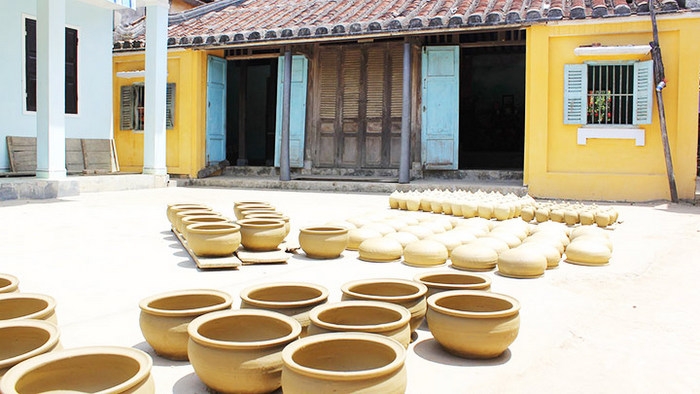About 3 km from the ancient town of Hoi An, Thanh Ha Pottery Village is a special highlight in the journeys to the heritages along the central region. In the over 500-year-old village, the skilful hands of artisans have blended earth, water and fire to create a special “dance” that is the quintessence of Quang Nam Province’s pottery.

Thanh Ha pottery village has preserved traditional method of making pottery. (Photo: NDO)
Located on the banks of Thu Bon River, the ancient traces of the ancient village that were left on Thanh Ha land is a space filled with a typical red-brown colour, the stoves to bake pottery products in a traditional method and the sound of ‘tu huyt’ (a kind of toy with a squeaky sound that children play with and blow along the roads). On the occasion of Lunar New Year, villagers held a spring welcoming ritual at Nam Dieu Temple on the tenth day of the first lunar month to commemorate their ancestors and pray for a peaceful new year. The festival featured various attractive folk games.
The first destination when visitors come to the village should be the Thanh Ha terra-cotta park, a miniature pottery museum. Covering an area of nearly 6,000 square metres, the park was methodically invested in and meticulously designed. Its architecture was divided into nine separate zones. In addition to preserving the artifacts and documents related the cultural heritages, the park consists of a space for visitors to experience the handicraft of making pottery products. Another interesting and unique area is designed for displaying famous architectural works of Vietnam and the world that were created with terra-cotta. They affirmed the vitality of Thanh Ha pottery, as well as the quintessence of Vietnamese pottery in general, in contemporary life.
Stepping out of the terra-cotta park, visitors can enjoy the daily life of local people, with the roads decorated by various products, ranging from bricks, pots, vases and jars to small souvenirs including ‘to he’ (also call tu huyt), animals and lamps. They were neatly arranged on both sides of the road to dry.
Many people have maintained their family’s workshops where the hard work could not make them lose their love for the craft. It is a hand-made process with different stages, from grinding, filtering and kneading the clay to shaping the rotary turntable to drying and baking pottery products. The talented hands of the locals were promoted to make products that bear their own brand of Thanh Ha Pottery Village.
Nguyen Le
Translated by NDO